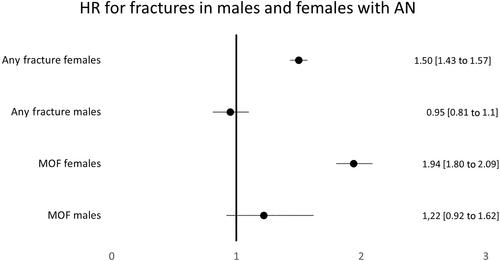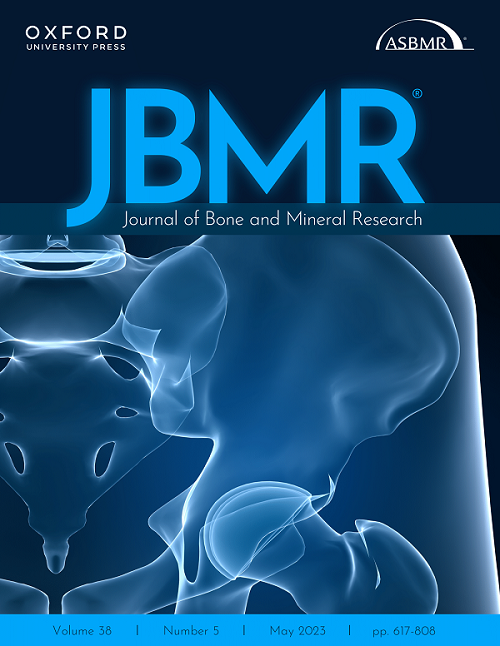下载PDF
{"title":"40年间神经性厌食症患者骨折风险分析","authors":"Mette Søeby, Sigrid Bjerge Gribsholt, Loa Clausen, Bjørn Richelsen","doi":"10.1002/jbmr.4901","DOIUrl":null,"url":null,"abstract":"<p>Researchers have reported increased fracture risk in patients with anorexia nervosa (AN), but more knowledge on the long-term risk and the effects of age, male sex, and time-related changes is still needed. We examined the long-term (up to 40 years) fracture risk among patients with AN compared to a matched comparison cohort from the general population. We utilized data from the Danish Health Care Registers to identify 14,414 patients with AN (13,474 females and 940 males) diagnosed between 1977 and 2018, with a median age of 18.6 years and median follow-up time of 9.65 years. We calculated adjusted hazard ratios (aHRs) with 95% confidence intervals (CIs) using Cox regression analysis for overall and site-specific fracture risks. The overall aHR of any fracture was 1.46 [95% CI: 1.36 to 1.48], with an aHR of 1.50 [95% CI: 1.43 to 1.57] for females and 0.95 [95% CI: 0.82 to 1.1] for males. For specific fractures we found an association with femur fractures both in females 4.06 [95% CI: 3.39 to 4.46] and in males 2.79 [95% CI: 1.45 to 2.37] and for fractures of the spine (females 2.38 [95% CI: 2.00 to 2.84], males 2.31 [95% CI: 1.20 to 4.42]). The aHR of any fracture decreased from 1.66 [95% CI: 1.52 to 1.81] in the period from 1977 to 1997 to 1.40 [95% CI: 1.33 to 1.40] from 1998 to 2018. In conclusion, we found that AN was associated with a 46% increased risk of any fracture up to 40 years after diagnosis. We found no overall increased risk in males, but in both sexes we found a particularly high site-specific fracture risk in the spine and femur. Fracture risk decreased in recent decades, indicating that more patients with AN have been diagnosed with presumably less severe disease and that the earlier detection and intervention of AN in recent years may translate into a lower facture risk. © 2023 The Authors. <i>Journal of Bone and Mineral Research</i> published by Wiley Periodicals LLC on behalf of American Society for Bone and Mineral Research (ASBMR).</p>","PeriodicalId":185,"journal":{"name":"Journal of Bone and Mineral Research","volume":"38 11","pages":"1586-1593"},"PeriodicalIF":5.1000,"publicationDate":"2023-08-14","publicationTypes":"Journal Article","fieldsOfStudy":null,"isOpenAccess":false,"openAccessPdf":"https://asbmr.onlinelibrary.wiley.com/doi/epdf/10.1002/jbmr.4901","citationCount":"0","resultStr":"{\"title\":\"Fracture Risk in Patients with Anorexia Nervosa Over a 40-Year Period\",\"authors\":\"Mette Søeby, Sigrid Bjerge Gribsholt, Loa Clausen, Bjørn Richelsen\",\"doi\":\"10.1002/jbmr.4901\",\"DOIUrl\":null,\"url\":null,\"abstract\":\"<p>Researchers have reported increased fracture risk in patients with anorexia nervosa (AN), but more knowledge on the long-term risk and the effects of age, male sex, and time-related changes is still needed. We examined the long-term (up to 40 years) fracture risk among patients with AN compared to a matched comparison cohort from the general population. We utilized data from the Danish Health Care Registers to identify 14,414 patients with AN (13,474 females and 940 males) diagnosed between 1977 and 2018, with a median age of 18.6 years and median follow-up time of 9.65 years. We calculated adjusted hazard ratios (aHRs) with 95% confidence intervals (CIs) using Cox regression analysis for overall and site-specific fracture risks. The overall aHR of any fracture was 1.46 [95% CI: 1.36 to 1.48], with an aHR of 1.50 [95% CI: 1.43 to 1.57] for females and 0.95 [95% CI: 0.82 to 1.1] for males. For specific fractures we found an association with femur fractures both in females 4.06 [95% CI: 3.39 to 4.46] and in males 2.79 [95% CI: 1.45 to 2.37] and for fractures of the spine (females 2.38 [95% CI: 2.00 to 2.84], males 2.31 [95% CI: 1.20 to 4.42]). The aHR of any fracture decreased from 1.66 [95% CI: 1.52 to 1.81] in the period from 1977 to 1997 to 1.40 [95% CI: 1.33 to 1.40] from 1998 to 2018. In conclusion, we found that AN was associated with a 46% increased risk of any fracture up to 40 years after diagnosis. We found no overall increased risk in males, but in both sexes we found a particularly high site-specific fracture risk in the spine and femur. Fracture risk decreased in recent decades, indicating that more patients with AN have been diagnosed with presumably less severe disease and that the earlier detection and intervention of AN in recent years may translate into a lower facture risk. © 2023 The Authors. <i>Journal of Bone and Mineral Research</i> published by Wiley Periodicals LLC on behalf of American Society for Bone and Mineral Research (ASBMR).</p>\",\"PeriodicalId\":185,\"journal\":{\"name\":\"Journal of Bone and Mineral Research\",\"volume\":\"38 11\",\"pages\":\"1586-1593\"},\"PeriodicalIF\":5.1000,\"publicationDate\":\"2023-08-14\",\"publicationTypes\":\"Journal Article\",\"fieldsOfStudy\":null,\"isOpenAccess\":false,\"openAccessPdf\":\"https://asbmr.onlinelibrary.wiley.com/doi/epdf/10.1002/jbmr.4901\",\"citationCount\":\"0\",\"resultStr\":null,\"platform\":\"Semanticscholar\",\"paperid\":null,\"PeriodicalName\":\"Journal of Bone and Mineral Research\",\"FirstCategoryId\":\"3\",\"ListUrlMain\":\"https://onlinelibrary.wiley.com/doi/10.1002/jbmr.4901\",\"RegionNum\":1,\"RegionCategory\":\"医学\",\"ArticlePicture\":[],\"TitleCN\":null,\"AbstractTextCN\":null,\"PMCID\":null,\"EPubDate\":\"\",\"PubModel\":\"\",\"JCR\":\"Q1\",\"JCRName\":\"ENDOCRINOLOGY & METABOLISM\",\"Score\":null,\"Total\":0}","platform":"Semanticscholar","paperid":null,"PeriodicalName":"Journal of Bone and Mineral Research","FirstCategoryId":"3","ListUrlMain":"https://onlinelibrary.wiley.com/doi/10.1002/jbmr.4901","RegionNum":1,"RegionCategory":"医学","ArticlePicture":[],"TitleCN":null,"AbstractTextCN":null,"PMCID":null,"EPubDate":"","PubModel":"","JCR":"Q1","JCRName":"ENDOCRINOLOGY & METABOLISM","Score":null,"Total":0}
引用次数: 0
引用
批量引用


 求助内容:
求助内容: 应助结果提醒方式:
应助结果提醒方式:


